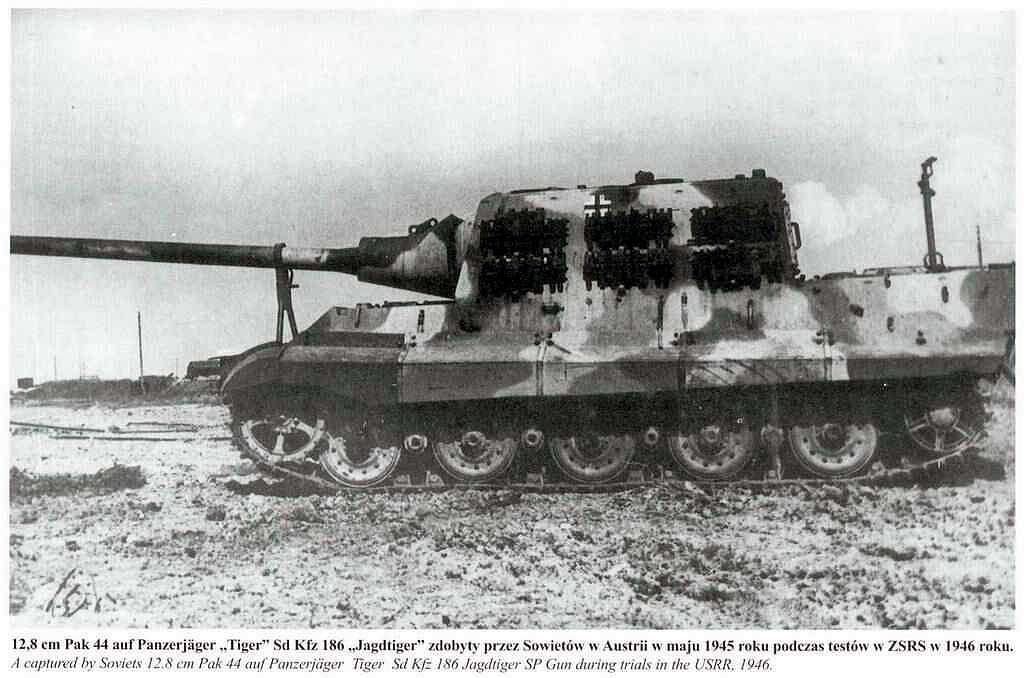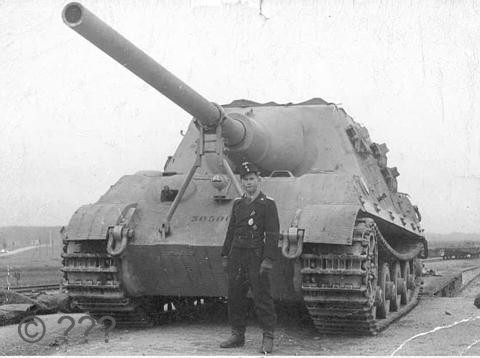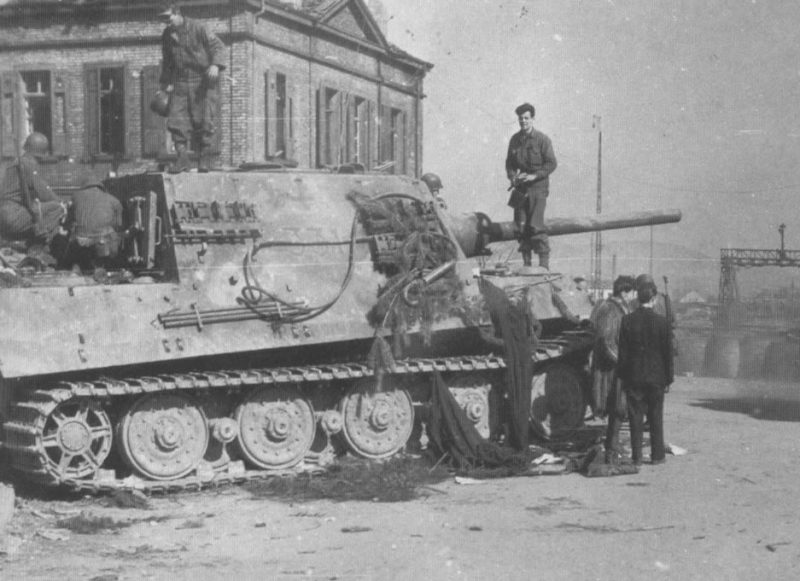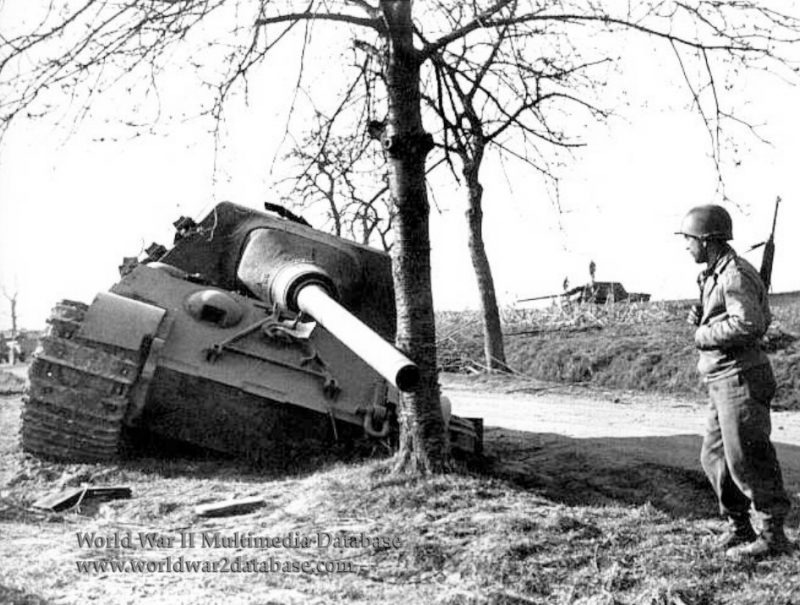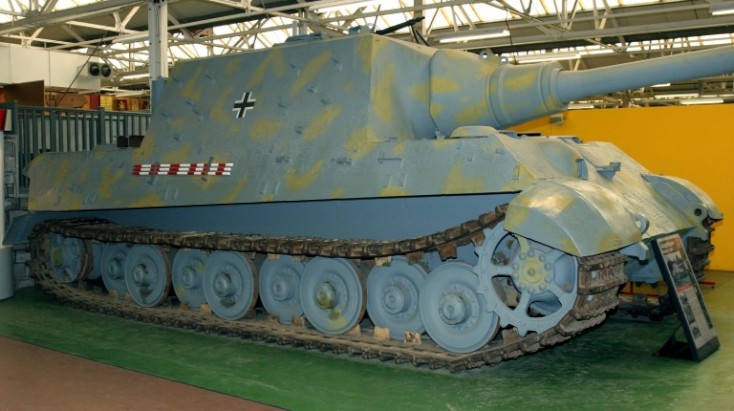
Jagdtigers only saw action during the final months of the war, and therefore only in Austria and Germany. In a good defensive position they were almost invulnerable but once they started to move they were likely to break down, run out of fuel or be destroyed by air attack.
Our exhibit was captured at Sennelager. It is unusual in having a suspension devised by Dr Porsche which employs longitudinal torsion bars instead of the more common transverse type. This tank is also coated in Zimmerit, a special paste which prevents magnetic charges from adhering to the hull and also improves the camouflage effect.
This Jagdtiger was one of two completed with the Porsche-designed longitudinal torsion-bar suspension, with wheels in pairs. It was not issued to the troops but used in trials at Sennelager, where it was found at the end of the war.
Precise Name: Jagdtiger
Other Names: SdKfz 186, Jagdpanzer VI, Pz Jag Tiger, 12.8cm PaK44 auf Pz Jag Tiger
DESCRIPTION
The Jagdtiger, (literally ‘Hunting Tiger’), was the largest and heaviest tracked vehicle to fight in World War II. Armed with a powerful gun and fitted with very thick armour it was also one of the most unwieldy.
The Jagdtiger project started in the early months of 1943 when it was decided to mount the 12.8cm Pak44 on a tank destroyer. The new vehicle was based on the chassis of the Tiger Aus B heavy tank or Tiger II (See E1952.33) and the first prototype was finished by April 1944.
The Jagdtiger retained the hull (slightly lengthened), suspension and 700 hp engine of the Tiger II. Extending the side plates of the Tiger II upwards and fitting new front and rear plates and an armoured roof created a massive superstructure. The front armour is 25cm (nearly 10in) thick and was completely proof against all Allied tank and anti-tank guns.
The 12.8cm gun protrudes through the front plate and is protected by a snout-like armoured mantlet. This gun was developed from an anti-aircraft gun. It fired a 28kg armour piercing projectile at 840 metres/sec and could pierce 16.7cms of steel armour inclined at 30 degrees at 1,000 metres. All Allied tanks were vulnerable. The gun had two drawbacks. The mounting only permitted a very limited traverse (10 degrees left and right) and the ammunition was so heavy that two loaders were needed.
The main gun was supplemented by a front mounted machine gun worked by the radio operator and on some vehicles by an external mounting for an anti-aircraft machine gun, carried on the rear engine deck. This was very exposed and looks like a desperate measure in the face of overwhelming Anglo-American air superiority.
Empty, the Jagdtiger weighed about 70 tons. Published estimates of the combat weight range up to 77 tons. All this weight taxed the rear mounted Maybach P230 petrol engine to the utmost. The power/weight ratio was about 9hp/ton compared to about 16/hp/ton in the similarly powered Panther. As a result the Jagdtiger had poor mobility, a typical cross country speed of about 16km/hr and a cross country range of less than 100km. The strain on the engine, transmission and suspension made it unreliable.
Jagdtiger production was limited to 77 vehicles against an order for 150. They were assembled at the Nibelungenwerke, St Valentin, Austria, between July 1944 and March 1945. Not all of them saw combat.
The standard Jagdtiger had the same type of suspension with transverse torsion bars as the Tiger II. Two vehicles (hull numbers 305001 and 305004) were built with a novel type of suspension that used longitudinal torsion bars. Designed by the Porsche company this suspension, like many of Dr Porsche’s innovations, proved a failure. However the failure of the Porsche suspension delayed production of the Jagdtiger while the it was redesigned to use standard Tiger II components.
The Tank Museum’s Jagdtiger is the second one fitted with the Porsche suspension (hull no. 305004). It was captured at the end of the war at the Sennelager testing ground and was never used in combat. Parts of the hull are covered in Zimmerit, a plaster like substance that was applied to the hull in ridges to prevent demolition charges fitted with magnets sticking to the hull. Zimmerit was applied to most German tanks manufactured between mid 1943 and September 1944.
The Jagdtigers were well suited to the type of defensive fighting that the German Army was engaged in 1944 and 1945. They were used as heavily armed and armoured mobile gun emplacements covering defended localities. A well camouflaged Jagdtiger could (and did) inflict considerable casualties on the more lightly armed and armoured British and American tanks. They were very vulnerable to fighter-bombers and to infantry anti-tank teams carrying rockets with shaped charge warheads because they lacked all- round defence.
Jagdtigers were issued to two Battalions: the 653rd Panzerjager abteilung (Tank hunting battalion) and the 512th Schwere Panzerabteilung (Heavy tank battalion). The 653rd participated in the Ardennes offensive starting in December 1944 while both fought in the defensive battles in the Rhineland in March 1945.
The Jagdtiger design is typical of the German tendency to produce very large armoured fighting vehicles. The design emphasises firepower and protection at the expense of mobility and is rather ‘unbalanced’. Whether the 77 Jagdtigers were the best use of scarce resources is questionable. It has been estimated that seven Hetzer Panzerjagers (see E1951.20 Jagdpanzer 38t Hetzer) could have been produced from the raw material and effort that went into building a single Jagdtiger.
Summary text by Mike Garth V1.0
Article by the Tank Museum, Bovington and there are many ways you can support them see here for more details www.TankMuseum.org
A message from the Tank Museum:
“Please Support Us: As a charity, we rely on public support for all our activities. Our work is funded entirely by people like you. With your support, we can continue to create content. With the right support we might be able to do it more regularly – and can be even more ambitious. Please Click on the Banner Below”
